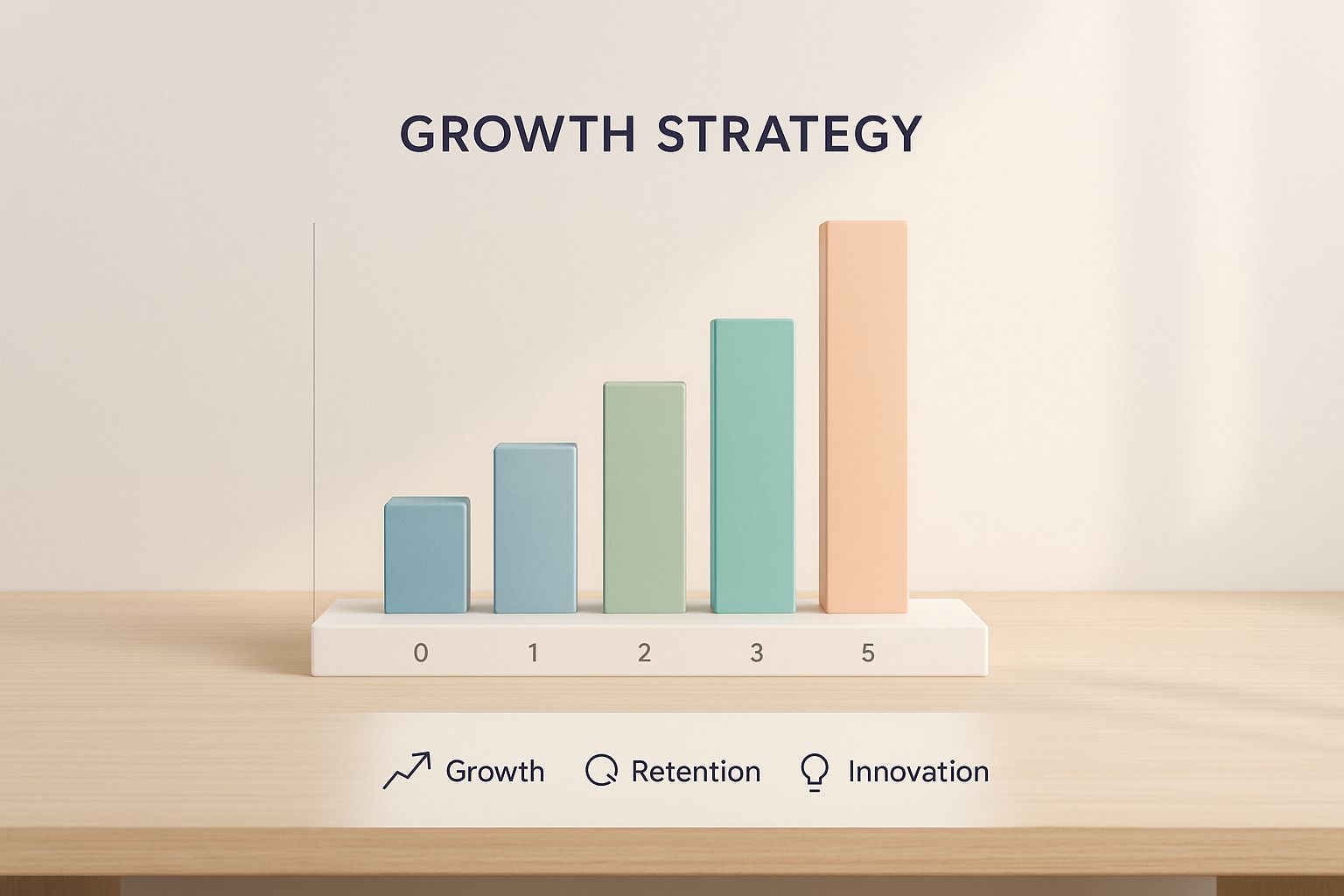The Hidden Power of Psychological Safety at Work
Psychological safety at work goes beyond simply creating a "comfortable" atmosphere. It's about cultivating an environment where employees feel empowered to take calculated risks, share their opinions openly, and admit mistakes without fear of negative repercussions. This sense of security unlocks significant potential within teams, fostering innovation and enhancing overall performance. This, in turn, leads to more effective and efficient teamwork and better results.
Why Psychological Safety Matters
A key benefit of psychological safety lies in its positive impact on communication. When team members feel secure, they're more inclined to share ideas openly and honestly. This open communication is crucial for effective problem-solving and informed decision-making.
For instance, imagine a team engrossed in a critical project. A junior member identifies a potential flaw. In a psychologically safe environment, this individual would feel comfortable voicing their concern, potentially averting a project disaster. Conversely, in an environment lacking psychological safety, that same team member might remain silent, fearing ridicule or negative consequences.
Additionally, psychological safety fuels innovation. It fosters a climate of experimentation and calculated risk-taking, two vital components for achieving breakthroughs. When employees aren't afraid to fail, they're more likely to explore new approaches and push boundaries. This willingness to experiment can lead to remarkable progress and provide companies with a competitive advantage. Cultivating a culture of psychological safety begins with establishing trust among team members. Explore these examples of helpful trust-building activities.
Psychological safety in the workplace is recognized as a key factor in employee engagement and business success. According to a study by Workplace Options, psychological safety plays a central role in talent retention and positive business outcomes. The study underscores the importance of a work environment where employees feel safe sharing their thoughts and concerns without fear of judgment or reprisal. This emphasis on psychological safety is especially important in today's diverse global workforce, where effective collaboration is essential. Learn more about the importance of psychological safety here.
Distinguishing Safety from Comfort
It's vital to understand that psychological safety isn’t about creating a workplace devoid of disagreement or difficult conversations. Instead, it's about fostering an environment where individuals feel comfortable expressing differing viewpoints, challenging existing norms, and seeking clarification.
This means that constructive conflict and respectful debate are not only permitted but actively encouraged. Such interactions are essential for individual and collective growth and learning. Ultimately, psychological safety empowers teams to realize their full potential by creating an environment where everyone feels valued, respected, and heard.
The Bottom-Line Impact You're Missing

This infographic illustrates how psychological safety positively impacts key business metrics. The data clearly shows a link between prioritizing psychological safety and improvements in areas like growth, retention, and innovation. These improvements have real, measurable effects on a company's bottom line.
High levels of psychological safety also play a crucial role in keeping employees happy and engaged. When people feel valued and safe at work, they're less likely to leave. In fact, research suggests only about 3% of employees are at risk of leaving organizations with strong psychological safety. This is a stark contrast to companies lacking this crucial element, where turnover can be significantly higher. Retaining talented employees is a powerful advantage, especially in today's competitive job market. For deeper insights into these statistics, see this BCG publication. You can also learn more about the importance of psychological safety in this helpful article: How Psychological Safety Is Key to High-Performing Teams.
Quantifying the ROI of Psychological Safety
Investing in psychological safety isn't just about creating a happy workplace. It's a strategic move with a measurable return on investment. Lowering employee turnover, for example, reduces costs associated with recruiting and training new hires. Furthermore, when employees feel safe to contribute ideas, innovation flourishes. This can lead to the development of new products and services, which directly boosts revenue growth.
From Quiet Quitting to Thriving Teams
The absence of psychological safety can have detrimental effects. Quiet quitting, where employees disengage without formally resigning, is a prime example. This quiet disengagement often leads to decreased productivity and lower quality work.
Conversely, in a psychologically safe environment, employees tend to be more engaged and motivated. This boost in engagement fosters improved productivity, better teamwork, and a greater willingness to share innovative ideas. These factors contribute to a more dynamic and successful organization.
To further understand the significant impact of psychological safety, let's examine a comparison table showcasing key business metrics in different workplace environments.
The following table, "The Impact of Psychological Safety on Key Business Metrics," compares various business outcomes in environments with high and low psychological safety.
| Business Metric | Low Psychological Safety | High Psychological Safety |
|---|---|---|
| Employee Turnover | High (e.g., 20% or more annually) | Low (e.g., 3% annually) |
| Innovation | Limited, few new ideas | Frequent, many new ideas implemented |
| Productivity | Reduced, quiet quitting prevalent | Improved, active engagement common |
| Employee Engagement | Low, dissatisfaction common | High, employees feel valued |
As the table highlights, high psychological safety correlates with lower turnover, increased innovation, and improved productivity and engagement. These are all critical factors contributing to a company's overall success.
Real-World Examples of Success
Many organizations are now embracing psychological safety as a key driver of success. Some companies that have implemented initiatives to boost psychological safety have seen positive results in employee satisfaction, retention, and profitability. These initiatives often involve leadership training to help managers foster psychological safety within their teams and feedback mechanisms to promote open communication and address concerns. These real-world examples underscore the practical benefits of prioritizing psychological safety.
The Reality Check: Where Most Teams Stand Today

This image captures a team meeting, but the expressions hint at underlying tensions. It illustrates a common scenario: despite increased awareness, many teams struggle with genuine psychological safety. This section explores the current state of psychological safety in the workplace and why it remains elusive for so many.
The Current State of Psychological Safety
While the benefits of psychological safety are clear, its presence in organizations is inconsistent. This gap between understanding its importance and actually achieving it requires attention. One factor contributing to this gap is the complexity of organizational structures and leadership styles. These can create barriers or, conversely, foster safe environments.
Hierarchical structures can sometimes stifle open communication, especially when employees fear repercussions for speaking up. Flatter structures, on the other hand, encourage open dialogue and can contribute positively to psychological safety. Leadership approaches also play a key role in shaping team dynamics and fostering a sense of safety.
Even with ideal organizational structures, cultural elements significantly influence psychological safety. A culture valuing conformity over dissent can inadvertently discourage employees from raising concerns or challenging the status quo. This can hinder psychological safety, even with supportive leadership. Understanding these cultural nuances is crucial for organizations aiming to cultivate psychologically safe environments. Learn more about psychological safety at work here. Only 50% of workers feel their managers create psychologically safe teams, and just 25% of employees with mental health challenges feel comfortable discussing them at work.
To better understand the varying levels of psychological safety, let's look at some statistical data:
Psychological Safety Metrics Across Different Organizations
Statistical data showing psychological safety levels across industries, company sizes, and demographics
| Category | Percentage Reporting High Psychological Safety | Key Challenges |
|---|---|---|
| Technology | 60% | Fast-paced environment, pressure to innovate |
| Healthcare | 55% | Hierarchical structures, fear of mistakes |
| Education | 45% | Limited resources, bureaucratic processes |
| Small Businesses (<50 employees)< td> | 70% | Close-knit teams, direct communication |
| Large Corporations (>500 employees) | 40% | Complex structures, communication barriers |
This table reveals some interesting insights. While smaller companies generally report higher levels of psychological safety, larger organizations face challenges in fostering such environments. Industry-specific pressures also play a role, with technology and healthcare sectors facing unique obstacles.
Generational and Demographic Differences
Generational and demographic differences add another layer of complexity. Different generations may have different expectations and experiences regarding workplace dynamics, shaping their perceptions of safety. Similarly, diverse demographic groups may have unique needs and concerns requiring tailored approaches.
Universal approaches to fostering psychological safety aren't always effective. Organizations must consider the specific challenges and perspectives of various groups within their workforce. Targeted strategies are crucial to meet their unique needs. Inclusive strategies are essential to ensure everyone feels safe and empowered to contribute fully.
Targeted Strategies for Improvement
Moving forward, fostering psychological safety requires a multifaceted approach. Organizations must consider their structure, leadership styles, and cultural elements to identify roadblocks. Addressing these challenges allows companies to create environments where all employees feel safe, respected, and empowered to speak up. This proactive approach will contribute to a more innovative, engaged, and productive workforce.
Leadership Behaviors That Transform Team Dynamics
Building psychological safety at work requires more than just good intentions. It demands specific leadership behaviors that actively cultivate a safe and supportive environment. These behaviors influence team dynamics, creating a space where open communication, risk-taking, and continuous improvement thrive.
Modeling Vulnerability and Open Communication
Effective leaders understand that psychological safety starts at the top. They model vulnerability by openly acknowledging their own mistakes and uncertainties. This encourages team members to do the same, fostering a culture where imperfections are seen as opportunities for growth.
Open communication, both giving and receiving, is also paramount. Leaders must actively solicit feedback and respond constructively, demonstrating that diverse perspectives are valued.
This means actively listening to team members, acknowledging their concerns, and responding thoughtfully. For example, instead of dismissing an idea, a leader might say, "That's an interesting perspective. Can you tell me more about your thinking?" This approach encourages dialogue and reinforces the message that all voices are important. Certain leadership styles can hinder psychological safety. Read more about avoiding ineffective leaders.
Transforming Mistakes into Learning Opportunities
How leaders respond to mistakes significantly impacts psychological safety. Rather than assigning blame, effective leaders frame mistakes as valuable learning experiences.
They encourage teams to analyze what went wrong, extract lessons learned, and apply those insights to future projects. This approach reduces the fear of failure, promoting a growth mindset within the team.
This fosters an environment where experimentation and innovation can flourish. When team members know that mistakes are viewed as opportunities for growth, they are more likely to take calculated risks and push boundaries.
Creating Effective Feedback Systems
Constructive feedback is essential for individual and team development. Leaders must create systems that encourage regular, open feedback. This could involve implementing regular check-ins, anonymous feedback tools, or dedicated time for team reflections. You might be interested in: How to master creating a feedback culture.
These systems should also ensure that feedback is delivered and received constructively, focusing on behaviors and actions rather than personal attributes. This promotes a culture of continuous improvement, where feedback is seen as a valuable tool for growth, not a source of criticism.
Addressing Power Dynamics and Inclusivity
Power imbalances can significantly impact psychological safety, especially for underrepresented groups. Effective leaders actively work to level the playing field, ensuring all team members feel comfortable speaking up, regardless of their position or background. This might involve creating specific forums for feedback or implementing strategies that encourage participation from quieter team members.
Additionally, leaders should be mindful of the unique challenges faced by remote and hybrid teams. Building psychological safety in these contexts requires intentional strategies, such as virtual team-building activities and regular online communication. These efforts help to bridge the physical distance and foster a sense of connection and belonging among team members. By consistently implementing these leadership behaviors, organizations can create a work environment where psychological safety thrives, leading to increased innovation, productivity, and overall team success.
Measuring What Matters: Your Psychological Safety Toolkit
Building a psychologically safe workplace takes more than just wanting it—it requires data. How can you know if your efforts are actually making a difference? This section explores practical tools and measurement approaches to assess your team's current state of psychological safety. This means moving beyond guesswork and using evidence-based methods to understand your team's reality.
Assessment Tools and Surveys
Surveys are valuable tools for gauging psychological safety. However, not all surveys are created equal. Some survey questions are more effective than others at predicting actual team performance. For example, questions focusing on specific behaviors, such as "How comfortable are you sharing a dissenting opinion in team meetings?" provide more actionable insights than general questions like "Do you feel safe at work?".
Additionally, consider incorporating open-ended questions. This allows for richer qualitative data, providing a more complete picture of your team's experiences. You might be interested in: Learn more in our article about how to improve employee satisfaction.
Observational Techniques
While surveys offer valuable quantitative data, observational techniques provide crucial context. Pay attention to team dynamics during meetings.
- Do some team members dominate the conversation while others remain silent?
- Are dissenting opinions welcomed or dismissed?
These observations can reveal hidden dynamics that surveys might miss.
For instance, if a team member consistently hesitates before speaking or avoids eye contact, it might indicate a lack of psychological safety. These subtle cues can provide deeper insights into the team's dynamics. They also help you identify areas for improvement.
Interpreting Your Findings
Once you've collected data through surveys and observations, the next step is interpretation. Look for patterns and trends.
- Are there specific areas where psychological safety is lacking?
- Are certain demographics or teams experiencing lower levels of safety than others?
These insights will help you develop targeted interventions.
For example, if your data reveals that junior team members feel less comfortable speaking up, you might implement mentorship programs or create smaller group discussions to encourage their participation.
Targeted Interventions and Benchmarking
Based on your assessment results, develop targeted interventions to address specific barriers. This might involve leadership training focused on fostering psychological safety, implementing new feedback mechanisms, or creating opportunities for team building.
Set realistic benchmarks for improvement and track your progress over time. This allows you to measure the effectiveness of your interventions and make adjustments as needed. This data-driven approach ensures that your efforts are focused and impactful.
Maintaining Momentum
Maintaining psychological safety requires ongoing effort. Initial enthusiasm can fade over time. To keep momentum going, regularly revisit your assessment tools, track your progress, and celebrate successes. This continuous improvement cycle helps embed psychological safety within your organizational culture. By consistently applying these techniques, you can create a sustainable, psychologically safe workplace where teams thrive.
The Intersection of Safety, Diversity, and Innovation
Psychological safety at work isn't just a nice-to-have; it's the foundation upon which true diversity and inclusion flourish. Building an inclusive workplace goes beyond simply hiring people from diverse backgrounds. It requires creating an environment where everyone feels comfortable sharing their unique perspectives.
Psychological Safety as a Catalyst for Inclusion
Studies show a strong link between psychological safety and the success of diversity and inclusion initiatives. When employees feel safe expressing themselves, diverse viewpoints are more readily shared and considered. This leads to a wider range of ideas and more informed decision-making.
For example, consider a team developing a new marketing campaign. A team member from a different cultural background might have valuable insights on how the campaign will resonate with their community. However, if they don't feel psychologically safe, they might hesitate to voice these crucial observations.
This underscores the importance of psychological safety in maximizing the potential of a diverse workforce. It allows companies to move past surface-level representation and truly harness the power of different perspectives. For further insights, check out this article: Learn more in our article about how team size affects employee happiness.
Addressing Diverse Needs for Psychological Safety
It's crucial to understand that psychological safety needs can differ across various identity groups. Past experiences with prejudice or exclusion can significantly shape an individual's sense of safety at work. Therefore, a uniform approach to cultivating psychological safety might not be effective.
Companies should consider the specific challenges faced by different groups and tailor strategies to address their unique needs. This could involve providing specialized training for managers on inclusive leadership or establishing Employee Resource Groups (ERGs) to foster support and a sense of community.
Tackling Microaggressions and Fostering Belonging
Microaggressions, subtle everyday slights or insults, can erode psychological safety, particularly for marginalized groups. Addressing these requires proactive education and clear communication about appropriate workplace conduct. Leaders must set an example by actively intervening when they witness microaggressions and establishing a culture of accountability.
Beyond addressing negative behaviors, businesses should actively cultivate a sense of belonging. This involves genuinely demonstrating a commitment to diversity and inclusion. This might include showcasing diverse leaders, celebrating cultural holidays, and providing opportunities for employees to share their personal stories.
Measuring Inclusive Psychological Safety
Measuring inclusive psychological safety requires more than general surveys. Organizations should collect data specifically reflecting the experiences of different demographic groups. This could involve analyzing survey data by demographic categories or conducting focus groups with specific ERGs.
This targeted data collection allows businesses to pinpoint any disparities in psychological safety experiences and create tailored interventions. For example, if data reveals that women feel less comfortable speaking up in meetings, companies can introduce strategies to address this, such as implementing clear meeting protocols that promote equal participation.
From Compliance to Innovation
Many companies view diversity and inclusion as a compliance requirement. However, when psychological safety is prioritized, diversity and inclusion become a true driver of innovation. This means that fostering a safe and inclusive environment benefits not only employees but also contributes directly to business success.
Ready to transform your workplace culture and unleash the power of your diverse teams? Happily.ai offers a comprehensive platform with data-driven tools and actionable insights to help you build a truly inclusive and high-performing company. Visit Happily.ai today to learn more and request a demo.









